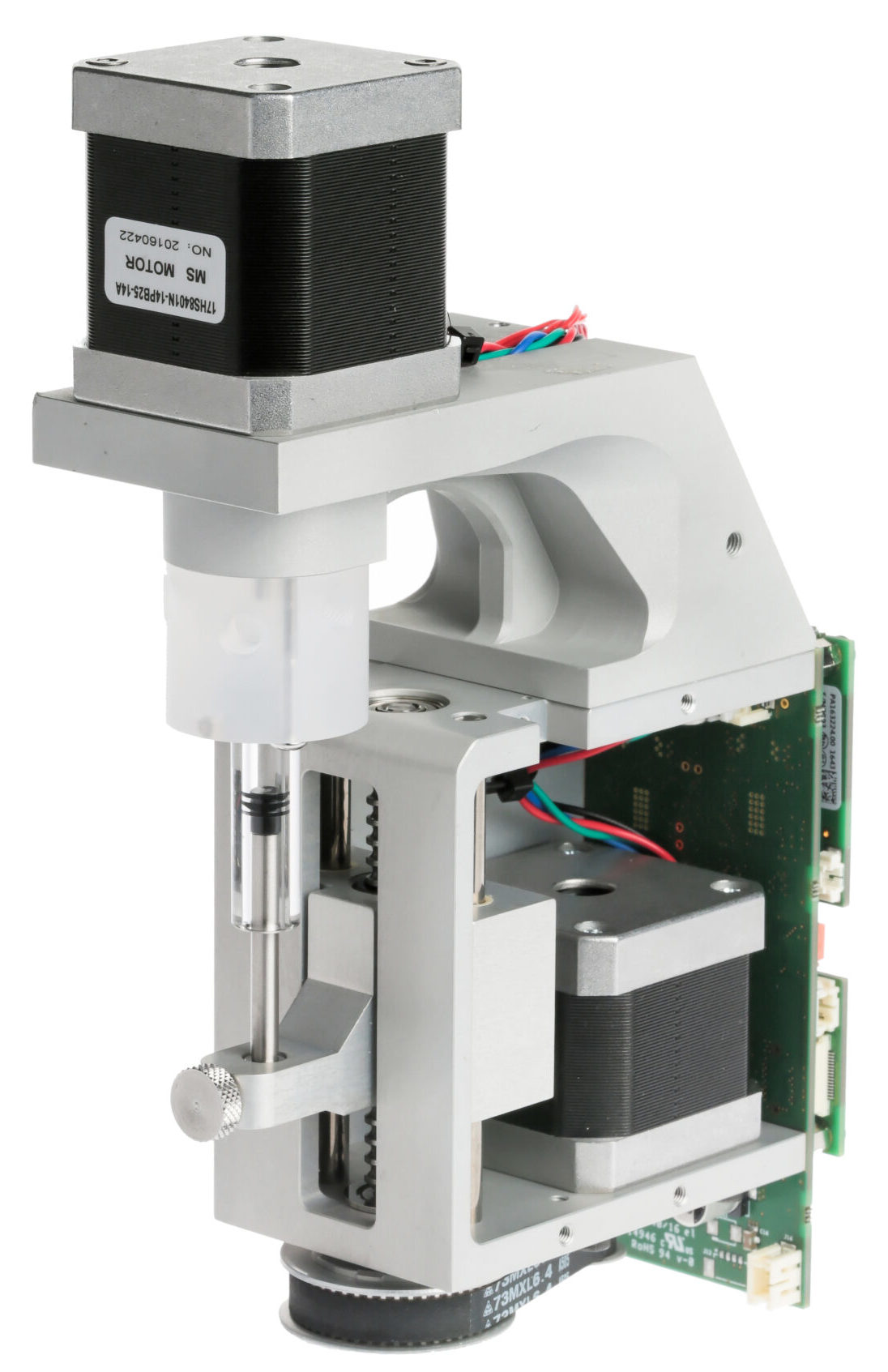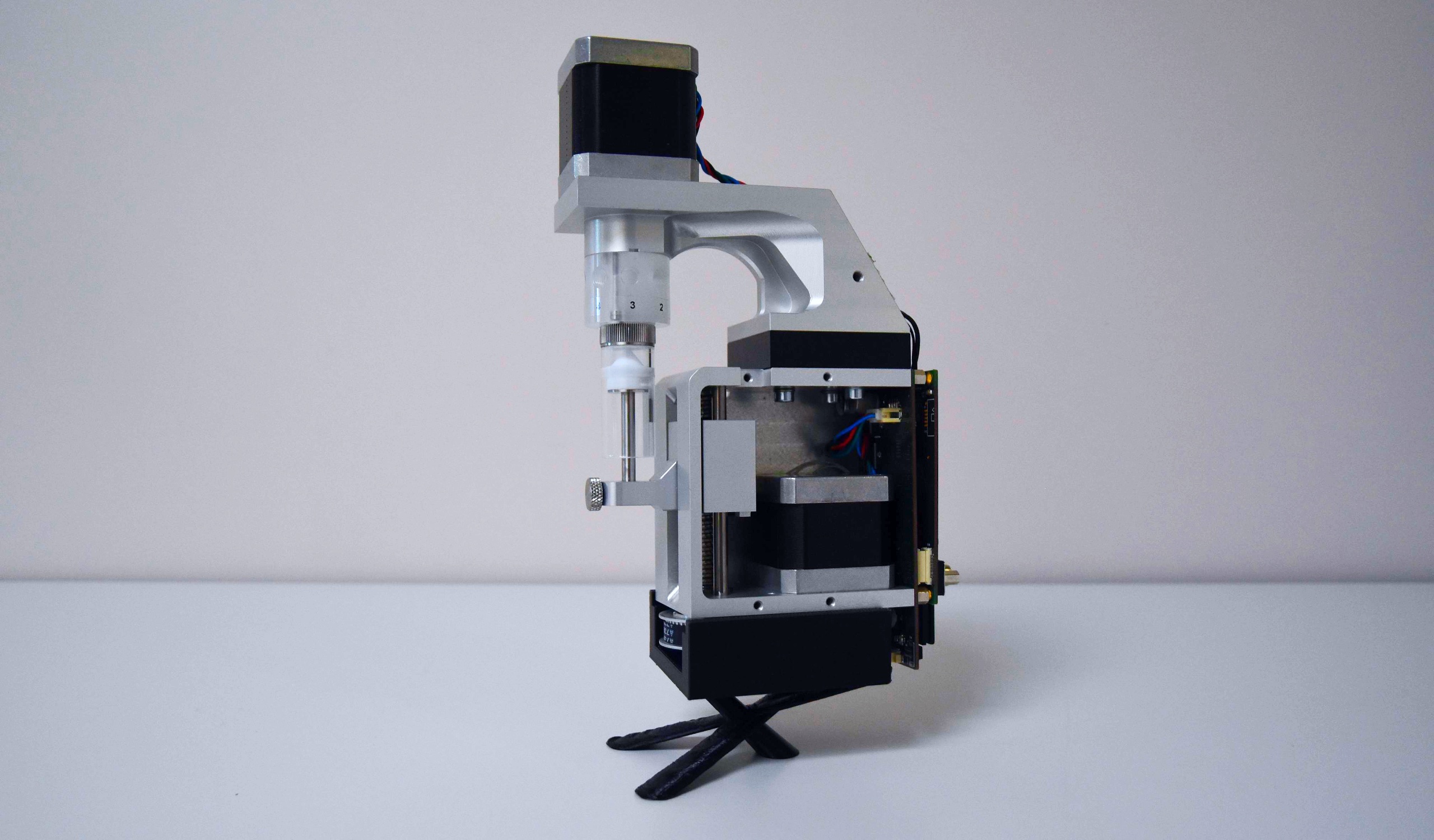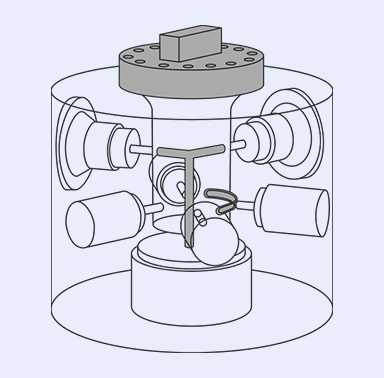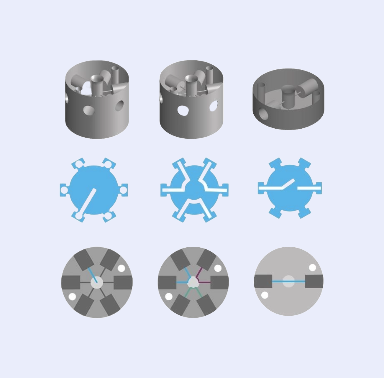
from 6 ports to 12 ports valve integrated

from 50 µl to 5 mL capacity

PTFE/PCTFE

Distribution valve
SPM – Industrial Programmable Syringe Pump
Quote configurator:
-
Summary
Select options to configure the product
Unveiling the SPM – Industrial Programmable Syringe Pump, an all-in-one OEM device that expertly handles samples with unmatched precision. This device is a revolutionary element in the field of microfluidics, merging a microfluidic syringe pump designed for industrial applications with a tailored high-precision AMF low-volume rotary valve.
Automated Programmable Microfluidic Syringe Pump (SPM) by AMF
SPM is an Industrial Programmable Syringe Pump (or a Sequential Microdispenser) and is suited for microfluidic automation, by design. The optimized space between the rotary valve and the syringe dramatically reduces the internal volume of the module, leads to low carryover volumes and ensures no dead volume. AMF SPM offers an optimal flow rate, proficiently diluting samples or reagents from milliliters down to nanoliters. It aspirates or dispenses liquids, controls the flow rate, and prepares complex mixes. This versatile tool can efficiently switch between air and liquid samples, ensuring no leakage due to its superior sealing capabilities.
As an OEM product, the SPM is highly customizable so as to meet the specific needs of your experiments:
- Wetted Material: The rotary valve’s wetted material is PCTFE (for the valve head), PTFE (valve rotor) and borosilicate glass (for the syringe) ensuring robustness and broad chemical compatibility.
- Channel Diameter: 500 µm to 1000 µm. The conjunction of small internal channel size with the unique AMF geometry allows it to reach extremely low internal volumes which can go as low as 600 nL*. This particular attribute optimizes your operation time, saves material (reagents, test materials and samples) and leads ultimately to reduced cost of operations for your final microfluidic application or instrument.
- Number of Ports: up to 12 radial ports. The valve’s number of ports will give you the ability to handle multiple fluids (from 6 to 12) within your microfluidic device (or detection chamber) and/or manipulate multiple fluids (sample to be tested, reagents, gases).
- Syringe volume: 50 µL up to 5000 µL (5 mL). Our high-precision syringes are made of borosilicate glass while the plunger is made of PTFE, making our device compatible with biological samples and a wide range of chemicals.
Advanced Microfluidics unique microfluidic SPM design:
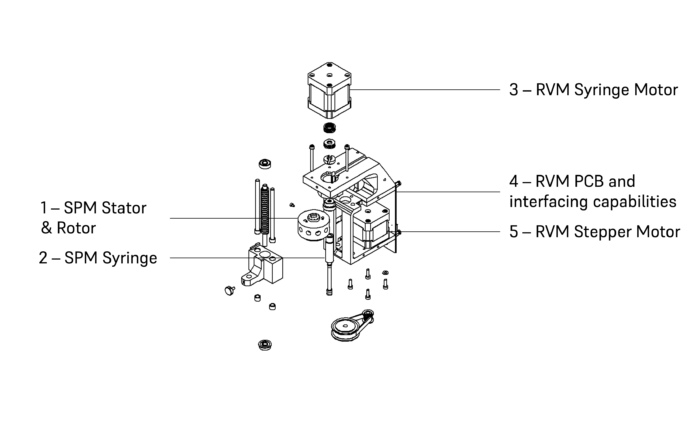
- Integrated sensor: the position sensor is directly integrated into the valve rotor (1) to ensure precise valve positioning and internal channel alignment between the rotor and the stator (1). An automatic procedure at power-up alerts the valve of its precise location.
- For your motor, choose between the fast model for a port switching speed as low as 150 ms and the low power model to reduce power consumption for better portable device integration and smaller power supply.
- Easy to use: the valve head (stator + rotor (1) + syringe (2)) can be easily removed and exchanged for preventive maintenance services. Our SPM is designed to be compatible with standard connectors widely used in microfluidics and beyond.
- High precision syringe pump (2)
Our SPM, as an OEM component, is ideally suited for industrial applications, designed for seamless integration into various systems. Tailored for those looking to incorporate robust microfluidic components into their setups, our versatile SPM can be customized to meet specific requirements, ensuring optimal performance in mass production environments. It supports diverse connective and communication needs, enhancing efficiency and scalability in industrial microfluidic applications.
*Our unique precise valves exhibit an internal volume (port-to-port) down to 600 nL (for a 4 ports switch valves) due to their exceptionally small 0.25 mm diameter channels.
More details
Enhance your expertise with our Application Notes, focused on microfluidic technology utilization:
Samples preparation for online liquid analysis with chemical reaction.
Microfluidic flow cytometry application for bacteria online monitoring in drinking water using BactoSense technology
Gain further insights with detailed guides on:
- Rotary Valve Carryover and Dead Volumes: Minimizing sample loss and contamination.
- Microfluidic Sequential Liquid Handling: Streamlining complex liquid management.
- Precision Liquid Handling: Advancing accuracy with port multiplexing techniques.
- …
For comprehensive information, visit our technical notes page.
Discover how our SPM syringe pump is advancing research across various fields. Explore the most recent publications where the SPM’s precision and reliability have been pivotal:
Maël Arveiler, Stephanie Ognier, Olivier Venier, Laurent Schiob and Michael Tatoulian – An innovative sequential flow platform for automated multi-step chemical processes – proof of concept with the separation of amine/alkene model mixtures – Reaction Chemistry & Engineering – Issue 11, 2023
You can find recent publications utilizing the laboratory version of the SPM, the LSPone, showcasing the same advanced technologies and applications in microfluidics.
Xiaokang Li, Hui Song Pak, Florian Huber, Justine Michaux, Marie Taillandier-Coindard, Emma Ricart Altimiras, Michal Bassani-Sternberg – A microfluidics-enabled automated workflow of sample preparation for MS-based immunopeptidomics – Cell Reports Methods – Volume 3, Issue 6 – 2023 – 100479 – ISSN 2667-2375
Christian Thoben, Nora T. Hartner, Moritz Hitzemann, Christian-Robert Raddatz, Manuel Eckermann, Detlev Belder, and Stefan Zimmermann – Regarding the Influence of Additives and Additional Plasma-Induced Chemical Ionization on Adduct Formation in ESI/IMS/MS – Journal of the American Society for Mass Spectrometry 2023 34 (5), 857-868
Ortiz-Perez A, van Tilborg D, van der Meel R, Grisoni F, Albertazzi L. – Machine learning-guided high throughput nanoparticle design – ChemRxiv. 2023
For more comprehensive details or to explore older publications featuring our SPM, please don’t hesitate to contact us.
- SPM – Industrial Programmable Syringe Pump – Datasheet – P100-O (50 µL to 1 mL syringe size)
- SPM – Industrial Programmable Syringe Pump – Datasheet – P101-O (2.5 mL & 5 mL syringe size)
- SPM – Industrial Programmable Syringe Pump – Operating Manual
For more detailed information, firmware, maintenance or software visit our Documentations & Downloads page.
SPM P100-O (50 µL to 1 mL syringe size)
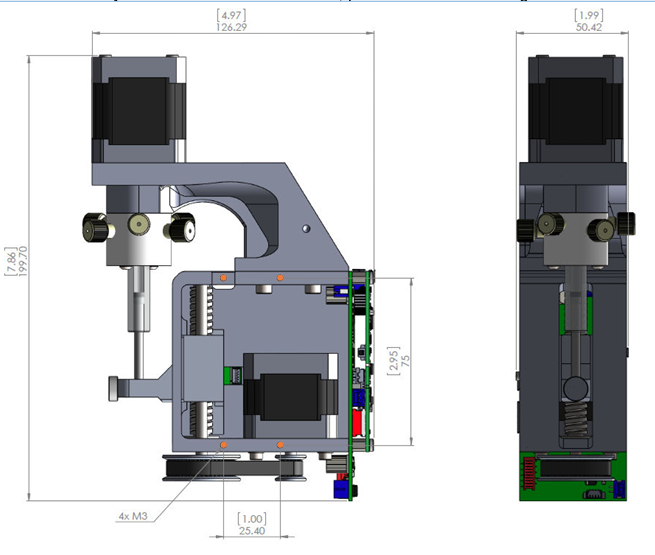
SPM P101-O (2.5 mL & 5 mL syringe size)

| Description | Specification: SPM P100-O (50µL to 1mL syringe size) | Specification: SPM P101-O (2.5 & 5 mL syringe size) |
|---|---|---|
| Operating temperature | 15 – 45°C (59-113°F) | 15-45°C (59-113°F) |
| Operating humidity | 20-80%, non condensing | 20-80%, non-condensing |
| Max. pressure | 5 bars (72 psi) | 5 bars (72 psi) |
| Wetted materials | PTFE or UHMW-PE, PCTFE and borosilicate glass | PTFE or UHMW-PE, PCTFE and borosilicate glass |
| Dead volume | None | None |
| Carryover volume | 1.5 – 10.2 μL (configuration dependent) | 18.1 – 34 μL (configuration dependent) |
| Plunger travel | 30 mm with 96,000 micro-steps for nearly pulseless flow | 30 mm with 96,000 micro-steps for nearly pulseless flow |
| Plunger resolution | Selectable 3,000 steps (standard) / 24,000 steps (high) | Selectable 3,000 steps (standard) / 24,000 steps (high) |
| Plunger drive | Screw drive with linear encoder for step loss detection | Screw drive with linear encoder for step loss detection |
| Valves configuration | Zero-dead-volume multi-port distribution with angular encoder | Zero-dead-volume multi-port distribution with angular encoder |
| Tube port fittings | Standard 1/4 – 28 UNF, flat-bottom | Standard 1/4 – 28 UNF, flat-bottom |
| Cross-contamination | Typically from 1/100 to 1/1000 per cleaning cycle | Typically from 1/100 to 1/1000 per cleaning cycle |
| Accuracy | < 1% deviation from expected value at full stroke | < 1% deviation from expected value at full stroke |
| Electrical interface | USB mini, 9–pin D–Sub (other upon request) | USB mini, 9–pin D–Sub (other upon request) |
| Interface | USB mini, RS-232, RS-485 | USB mini, RS-232, RS-485 |
| Communication type | Serial (serial over USB, RS-232, RS-485) | Serial (serial over USB, RS-232, RS-485) |
| Power | 18 VDC, 2.2 A peak, 40 W (18 VDC optimized for battery use) | 18 VDC, 2.2 A peak, 40 W (18 VDC optimized for battery use) |
| Time for full stroke | 2 – 6000 seconds | 2 – 6000 seconds |
| Dimensions | 199.7 x 126.3 x 50.5 mm | 211.84 x 136.62 x 49.57 mm |
| Weight | 1.5 kg | 1.6 kg |
Valve specifications
| Ref. | Configuration | Wetted materials | Internal volume | Carryover volume | Fluid path diameter | Max. pressure |
|---|---|---|---|---|---|---|
| V–D–2–6–050–C–P | 6 ports ultra-low carryover volume | PCTFE, PTFE | 5.2 μL | 1.5 μL | 0.5 mm | 7 bars |
| V–D–1–6–050–C–P | 6 ports low carryover volume | PCTFE, PTFE | 3.5 μL | 2.6 μL | 0.5 mm | 7 bars |
| V–D–1–8–050–C–P | 8 ports low carryover volume | PCTFE, PTFE | 3.5 μL | 2.6 μL | 0.5 mm | 7 bars |
| V–D–1–8–100–C–P or U | 8 ports low carryover volume | PCTFE, PTFE or UHMW–PE | 14.1 μL | 10.2 μL | 1 mm | 7 bars |
| V–D–1–10–050–C–P or U | 10 ports low carryover volume | PCTFE, PTFE or UHMW–PE | 4.5 μL | 2.8 μL | 0.5 mm | 7 bars |
| V–D–1–10–100–C–P or U | 10 ports low carryover volume | PCTFE, PTFE or UHMW–PE | 18.1 μL | 11 μL | 1 mm | 7 bars |
| V–D–1–12–050–C–P or U | 12 ports low carryover volume | PCTFE, PTFE or UHMW–PE | 4.5 μL | 2.8 μL | 0.5 mm | 7 bars |
Valve heads are interchangeable. Other models and customs available upon request
Syringe specifications
| Reference | Volume | Plunger material | Min. flow rate | Max. flow rate | Min. dosing volume |
|---|---|---|---|---|---|
| S–50–P | 50 μL | PTFE | 0.5 μL/min | 1 500 μL/min | 0.1 μL |
| S–100–P | 100 μL | PTFE | 1 μL/min | 3 000 μL/min | 0.2 μL |
| S–250–P | 250 μL | PTFE | 2.5 μL/min | 8 000 μL/min | 0.5 μL |
| S–500–P or S–500–U | 500 μL | PTFE or UHMW-PE | 5 μL/min | 15 000 μL/min | 1 μL |
| S–1000–P | 1000 μL | PTFE | 10 μL/min | 30 000 μL/min | 2 μL |
| S-2500-P | 2.5 mL | PTFE | 25 μL/min | 75 000 μL/min | 5 μL |
| S-5000-P | 5 mL | PTFE | 50 μL/min | 150 000 μL/min | 10 μL |
Chemical compatibility The wetted materials being PTFE, PCTFE and borosilicate glass, this pump offers an exceptional compatibility to most chemicals and biological samples.
Optional:
It is possible to add a heating/cooling module around the syringe to suit your specific application.
FAQs: Navigating the SPM - Industrial Programmable Syringe Pump
Welcome to our detailed FAQ section, crafted to enhance your understanding of the SPM – Industrial Programmable Syringe Pump – a game-changer in microfluidic automation. Designed for precision and adaptability, the SPM combines a state-of-the-art syringe pump with a high-precision rotary valve, tailored for diverse industrial applications. In this section, discover answers to common queries about its functionalities, integration capabilities, and technical specifications. Whether you’re an experienced engineer or new to the field of microfluidics, our FAQs provide the insights you need to harness the full potential of the SPM in your laboratory or industrial setting.
The SPM – Industrial Programmable Syringe Pump has no dead volume, ensuring efficient and precise fluid handling. This feature is crucial in microfluidic applications, where minimizing waste and ensuring accuracy in sample handling are paramount. The absence of dead volume means more effective use of reagents and samples, enhancing the overall efficiency of laboratory processes.
The SPM’s carryover volume ranges from 1.5 to 10.2 µL, depending on the configuration. This optimized carryover volume is critical in microfluidics for reducing cross-contamination and ensuring the integrity of sequential sample handling. The design of the SPM, focusing on precise fluid control, contributes to its effectiveness in applications where minimizing sample contamination is essential.
The SPM’s internal volume can be as low as 600 nL, significant in applications requiring precision and minimal sample waste. This low volume, achieved through advanced microfluidic design, optimizes operation time and reduces material costs, making the SPM an efficient choice for high-precision fluid handling in various applications.
The SPM seamlessly integrates with existing microfluidic systems, thanks to its customizable design and compatibility with standard connectors. Its ability to handle multiple fluids and precise control makes it an ideal component in lab-on-a-chip applications and other complex microfluidic setups.
The average lead time for the SPM is around 4 weeks, varying based on configuration. This efficient lead time ensures quick integration in lab settings, aligning with the fast-paced requirements of modern microfluidic research and industrial applications.
The SPM’s superior sealing capabilities, combined with its high-precision design, ensure minimal leakage and accurate fluid handling. This efficiency is a result of its Swiss-engineered precision, making it a reliable choice for demanding microfluidic applications where leakage control is crucial.
The SPM offers optimal flow rate control, efficiently handling fluids from milliliters to nanoliters. This precise control is essential in applications requiring accurate dilution and dispensing of samples and reagents, making the SPM an invaluable tool in a variety of microfluidic applications.
The SPM’s microfluidic syringe pump, designed for industrial applications, provides unmatched precision in fluid handling. Its high-precision design is suitable for a wide range of applications, from biological sample handling to chemical analysis, offering reliable and accurate fluid control.
The SPM is designed to handle a maximum pressure of 7 bars (102 psi), making it suitable for a variety of high-pressure microfluidic applications. This capability allows it to operate efficiently under varying pressure conditions, ensuring consistent performance and reliability.
The SPM uses materials like PTFE, UHMW-PE, PCTFE, and borosilicate glass in its wetted parts, ensuring broad chemical compatibility and robustness. These materials make the SPM suitable for handling a wide range of chemicals and biological samples, enhancing its versatility in various applications.
The SPM features a plunger with high resolution and travel, enabling nearly pulseless flow and precise fluid control. This precision is crucial for applications requiring accurate fluid dispensing and minimal variation in flow rates, making the SPM a key tool in precision microfluidics.
The SPM offers an electrical interface with options like USB mini and 9–pin D–Sub, supporting various communication types like Serial. This versatility in connectivity allows for easy integration with different control systems and enhances its usability in various microfluidic setups.
The SPM is designed with standard 1/4 – 28 UNF, flat-bottom tube port fittings, ensuring compatibility with a wide range of tubing types. This feature allows for easy integration with existing systems and flexibility in setting up various microfluidic configurations.
As an OEM product, the SPM is highly customizable to meet specific experimental needs. This adaptability allows users
They trust us
From top-tier academic institutions to pioneering biotech companies, Advanced Microfluidics is the preferred partner for innovative microfluidic solutions. Our track record of excellence and precision has earned us the trust of industry leaders, driving us to push boundaries and redefine possibilities together.





